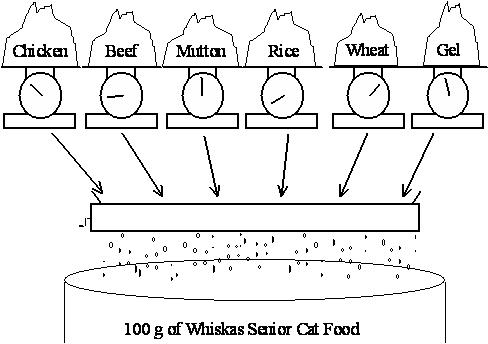Blending Problem#
This problem is taken from PuLP case studies.

This example shows some basic usage of OptFlow similar to other modeling languages (CVXPY, PuLP, Pyomo, etc.), such as flow.Variable, flow.Input and flow.Constant, and how NumPy arrays np.ndarray can be used as constants in OptFlow.
# Author: Anonymized for paper review
# Case Study: The Blending problem
# https://coin-or.github.io/pulp/CaseStudies/a_blending_problem.html
import optflow as flow
x_1 = flow.Variable(flow.continuous)
x_2 = flow.Variable(flow.continuous)
obj = 0.013 * x_1 + 0.008 * x_2
constraints = [
x_1 + x_2 == 100.0,
0.1 * x_1 + 0.2 * x_2 >= 8.0,
0.08 * x_1 + 0.1 * x_2 >= 6.0,
0.001 * x_1 + 0.005 * x_2 <= 5.0,
0.002 * x_1 + 0.005 * x_2 <= 0.4
]
prob = flow.Problem(objective=obj, constraints=constraints, sense=flow.minimize)
opt_obj = prob.solve(solver=flow.programming)
print(opt_obj)
print(x_1.optimized_value)
print(x_2.optimized_value)
# Author: Anonymized for paper review
# Case Study: The Blending problem
# https://coin-or.github.io/pulp/CaseStudies/a_blending_problem.html
import optflow as flow
import numpy as np
N = 2
x = flow.Variable(flow.continuous, shape=(N, ))
cost = flow.Input(dtype=flow.float64, shape=(N, ))
percentage = flow.Constant(dtype=flow.float64, shape=(4, N),
value=np.array([[0.1, 0.2], [0.08, 0.1], [0.001, 0.005], [0.002, 0.005]]))
obj = sum(cost[i] * x[i] for i in range(N))
constraints = [
x[0] + x[1] == 100.0,
percentage[0, 0] * x[0] + percentage[0, 1] * x[1] >= 8.0,
percentage[1, 0] * x[0] + percentage[1, 1] * x[1] >= 6.0,
percentage[2, 0] * x[0] + percentage[2, 1] * x[1] <= 5.0,
percentage[3, 0] * x[0] + percentage[3, 1] * x[1] <= 0.4
]
prob = flow.Problem(objective=obj, constraints=constraints, sense=flow.minimize)
opt_obj = prob.solve(solver=flow.programming, inputs={cost: np.array([0.013, 0.008])})
print(opt_obj)
print(x[0].optimized_value)
print(x[1].optimized_value)
# Author: Anonymized for paper review
# Case Study: The Blending problem (with input)
# https://coin-or.github.io/pulp/CaseStudies/a_blending_problem.html
import optflow as flow
x_1 = flow.Variable(cat=flow.continuous)
x_2 = flow.Variable(cat=flow.continuous)
cost_chicken = flow.Input(dtype=flow.float32)
cost_beef = flow.Input(dtype=flow.float32)
protein_lb = flow.Input(dtype=flow.float32)
fat_lb = flow.Input(dtype=flow.float32)
fibre_ub = flow.Input(dtype=flow.float32)
salt_ub = flow.Input(dtype=flow.float32)
obj = cost_chicken * x_1 + cost_beef * x_2
constraints = [
x_1 + x_2 == 100.0,
0.1 * x_1 + 0.2 * x_2 >= protein_lb,
0.08 * x_1 + 0.1 * x_2 >= fat_lb,
0.001 * x_1 + 0.005 * x_2 <= fibre_ub,
0.002 * x_1 + 0.005 * x_2 <= salt_ub
]
prob = flow.Problem(objective=obj, constraints=constraints, sense=flow.minimize)
opt_obj = prob.solve(solver=flow.programming, inputs={
cost_chicken: 0.013, cost_beef: 0.008, protein_lb: 8., fat_lb: 6., fibre_ub: 2., salt_ub: .4})
print(opt_obj)
print(x_1.optimized_value)
print(x_2.optimized_value)
[Run Online Demo] (password:  )
)